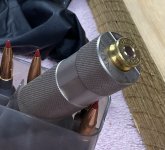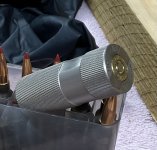Case head expansion is an old school (stone knives and bear skins)way to monitor excessive pressure.
In many rifle designs (Such as 1903 and Win M-70) the cone breech leaves the case head unsupported by chamber. The brass is designed for this. If the case head is expanding,its time to pay attention.
But these "pressure sign" indicators are something like tea leaves,bat wings and fire smoke paths. Not to be ignored,but not the last word.
Case head expansion is a pretty credible "sign" .
The case head area is concentric with he primer pocket. Kind of like a donut and donut hole. Generally if the donut hole gets bigger so does the donut.
The loosening of primer pockets would generally suggest an accompanying case head expansion. Maybe.
But I don't suggest jumping to conclusions.
It might be interesting to get a series of pin gauges increasing in size by .0001 per pin to gauge the pockets versus the case heads.
With enough samples and enough data and enough "isolation of variables" you might be able to observe a trend.
Sounds tedious. Not necessarily fun. IMO, as a general trend, if we recognize the "margin of safety" our component suppliers recommend ,work up our loads,etc.... I'll say I started loading in the 1960's buying Hodgdon powder dispensed into my bleach bottle or the brown paper bag Louis P B would provide. $ 1.60 a lb.No Youtube. No forums. Some had "Powley P-max" .... but not me .Q+A columns by PO Ackley and Elmer. Warren Page articles. And the trusty load manual.
And,of course, being young,I did plenty of "Dumb" . Intial load development for my 257 Roberts AI found me at the range next to a gentleman with an Oehler 33 Chronograph. I asked him if he'd clock a few. He was happy to.
He got real excited , started dancing and waving his hat. "What are you shooting? "
"IMR4350 behind a Sierra 100 gr boat tail. "
"Well,you are getting 3400 fps with less than 10 fps spread!."
I pondered on that a bit. I was right there with the hotter 25-06 and 257 Weatherby loads in the book. There ain't any magic or free lunch. I was just a few granules over book MAX. That old Mexican Mauser ..... was old.
I considered the bolt going through my cheekbone. 3400 fps? Hmmmm .
Probably ought to back off a bit.
Pushing the limit,I surmised,was not only approaching the edge of the cliff,it was dancing at the edge of the cliff. After a couple of beers.
Anyway,well over 50 years worth of reloading ,finding my own path and not one time did anything get too exciting. No kabooms.
Stretch rings and case separations are a different "Symptom " than "head expansion" . Head expansion,IMO, tells me pressure is (maybe) high enough
to cold flow brass. Stretch rings tell me "There is enough head clearance to shorten case life". That can happen at safe pressures . There are case measuring and resizing adjustments we can try to control head clearance.
It hurts to find "that load" that results in your lot of 223 brass being scrap to loose pockets. Generally,it takes a bad screw up to Kaboom with a .223/5.56.
Like pistol powder.
But you can easily loosen primer pockets . A few extra fps can mean scrapping all that expensive,hard to come by brass you laboriously prepped.
Dang it!
Good reason to NOT push the limit. Better to add a click or two elevation at the sights.


